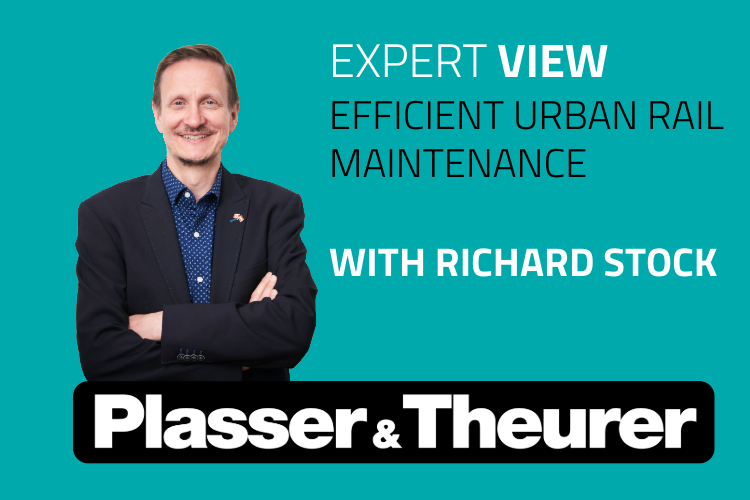Expert View: Efficient urban rail maintenance
Posted: 18 September 2025 | Richard Stock | No comments yet
Richard Stock, Head of Rail Solutions at Plasser & Theurer, explains how their compact grinding trailer, uses unique block grinding technology for both preventive and corrective maintenance to improve rail condition and reduce noise.


The Automated Track Machine Oscillator (ATMO) trailer, developed by Plasser & Theurer within the European Shift2Rail technology initiative, is an innovative solution for rail maintenance in urban environments. Urban rail networks face unique challenges such as dense train intervals, short maintenance windows, sharp curve radii (often below 25m), low maximum axle loads, and embedded tracks shared with other street traffic. Noise and vibration caused by rail surface defects like corrugation are also significant concerns in these densely populated areas.
The ATMO is designed as a compact, flexible trailer that can be pushed or pulled by almost any suitable rail-bound or high-rail vehicle, including regular tramway vehicles, making it adaptable for use during revenue operations or non-operational hours. It features its own integrated power supply for the grinding units, and a 2600-litre water tank for wet grinding (grinding output enhancement and spark suppression).
The ATMO employs block grinding technology, capable of operating in two modes. In oscillating mode, the grinding blocks move back and forth with adjustable frequency and amplitude, while in sliding mode, they are dragged along the rail without oscillation. The grinding units, completely redesigned for urban applications, continuously adapt to the railhead shape, treating the running surface without gauge-face contact. A specially designed guidance system ensures the stones remain centered on the rail even in tight curves (down to 17m radii) and compensate for gauge variations. Each of the two grinding units per side holds two block grinding stones and the vertical grinding stone force can be varied within certain parameters. The ATMO can operate effectively at speeds ranging from 0 km/h (oscillation mode only) to over 30 km/h, with no minimum speed required for successful processing.
Extensive testing at Wiener Linien demonstrated metal removal of 0.01mm per pass at 4km/h in oscillating mode which makes this the perfect tool for regular preventive maintenance. Furthermore, the ATMO was used to remove corrugation at a grinding speed of 30 km/ with oscillation mode in 10 to 20 passes dependent on corrugation severity. This had significant impact on noise and vibration development showing train type dependent noise reductions of up to 8 dB.
Customer applications further validated these findings.
In Odensee, the ATMO successfully removed a hard-pressed, low-friction layer caused by excessive rail lubrication combined with street vehicle and vegetational contamination, leading to subjective reports from tram drivers of improved, quieter running behaviour.
In Graz, the ATMO effectively reduced corrugation, with results consistent with the Wiener Linien tests, achieving significant reductions in longitudinal waviness after only three passes in some sections. In this case the ATMO was used as part of an integrated treatment process that included continuous pre- and post- measurements utilizing ROSPECT measurement vehicle by Robel Rail Automation.
In Cologne, the ATMO demonstrated its capability for both preventive grinding and the corrective removal of massive corrugation, requiring 160 passes for severe cases (1.1mm amplitude) and 60 passes for moderate cases (0.35mm amplitude) to be classified as corrugation-free.
The ATMO was also successfully used to remove honeycomb-like surface structures created by rail milling, preventing temporary tonal noise effects. A single pass in oscillating mode at 800m/h (0.8 km/h) significantly reduced waviness in the 10-30mm wavelength range, bringing it below regulatory thresholds.
In conclusion, the ATMO is a versatile and efficient rail grinding trailer, proven suitable for both regular preventive maintenance to keep rail surfaces free from defects and contamination, and for corrective interventions to remove corrugation, and post-milling surface structures. Its flexibility, speed capabilities, and positive impact on reducing noise and vibration make it a valuable tool for modern urban rail systems.
About the author


With over 20 years of industry experience, Richard Stock is the leading expert for rail management with focus on rail life extension. In his position at Plasser & Theurer as Global Head of Rail Solutions he is responsible to coordinate rail management topics like rail maintenance, rail welding and rail measurement technology in the extended company group.



